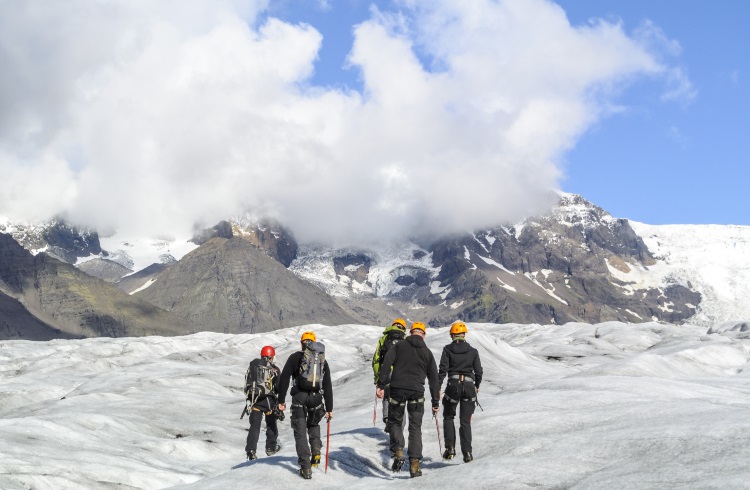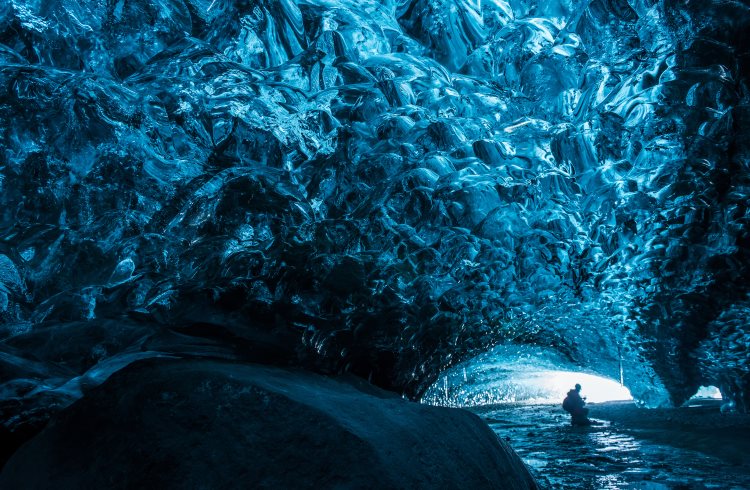7 Must-See Ice Caves, Lava Caves and Glaciers in Iceland
They don’t call it the “land of fire and ice” for nothing. No one should visit Iceland without exploring its spectacular ice caves, lava tubes, and mighty glaciers.
 Photo © iStock/Sjo
Photo © iStock/Sjo
- Sólheimajökull Glacier
- Mýrdalsjökull Glacier
- Lofthellir Lava Cave
- Vatnajökull Glacier
- Langjökull Glacier
- Drangajökull Glacier
- Hallmundarhraun
For your safety, all glacier hikes and cave trips must be conducted with a reputable guide.
Sólheimajökull Glacier
Just a two-hour drive from Reykjavik is beautiful Sólheimajökull, an outlet glacier of the Mýrdalsjökull glacier, the fourth largest in Iceland.
During your hike, you’ll need to strap on some crampons, don a helmet, and grab yourself an ice pick. You’ll explore ice formations and pass by deep crevasses before arriving at an ice wall for you to climb. This is where the ice picks come into play.
Seeing the black volcanic rock peeking out from the teal blue ice is a sight in itself. If you’re looking for a day trip from the capital, this glacier hike should feature prominently on your itinerary.
Difficulty Level: Easy (if just hiking) to Moderate (if climbing the ice wall)
Location: South / Southwest Iceland
Getting There: Two-hour drive from Reykjavik
Gear: Warm clothing, waterproof jacket and pants, hiking boots, gloves, and winter cap. You can rent any gear that you don’t have from equipment rental shops in Iceland.

Mýrdalsjökull Glacier
This is one of the most interesting glaciers in Iceland. You’ve probably heard of its neighbor, Eyjafjallajökull Glacier? The volcano beneath that glacier erupted in 2011, causing flight delays across Europe for weeks. There's a much larger volcano sitting beneath the Mýrdalsjökull Glacier, and it’s just a matter of time before that one erupts as well. But, at the time of writing, tours are still continuing to run and no dangers are imminent.
The glacier can be seen by air (helicopter), by snowmobile, or by foot. You can also enter the ice caves, but note that they aren’t as dramatically blue-colored as the Crystal Ice Cave.
Difficulty Level: Moderate. Most tours say you must be 16+ years to participate. You’ll hike around seven hours/day.
Location: South Highlands. North of the village of Vik.
Getting There: Helicopter tours depart from Reykjavík. Those who just want to visit the glacier can stay in Vik. Or, if you want to do the three-day hiking trip, the pick-up point is typically the BSI bus terminal in Reykjavík. Check with your tour operator.
Gear: For the multi-day hiking, many tour operators require you to bring your own sleeping bag. You’ll also want sturdy hiking boots and warm clothing.
Lofthellir lava cave
After hiking over the beautiful Búrfell lava field for around 20 minutes, you’ll arrive at a gaping hole in the ground. This is where you’ll descend deep into the 3,500-year-old Lofthellir cave to discover the largest ice sculptures found in a lava cave anywhere in the country.
This cave is for the adventurous – but maybe not for the claustrophobic. You’ll need to squeeze through several small, icy openings before arriving at a spacious cavern filled with ice sculptures in all sizes and shapes.
Difficulty Level: Easy-Moderate. Not suitable young children, the claustrophobic, or those who aren’t in good physical shape.
Location: Northeastern Iceland, near Lake Mývatn.
Getting There: Most tours offer free pick-ups from hotels in Mývatn. The drive to the lava cave takes about 45 minutes.
Gear: Warm, waterproof clothing (you’ll be sitting/sliding on ice), gloves and hat. Helmets, headlights
Vatnajökull Glacier
Located in the National Park of the same name, Vatnajökull glacier is the largest in Iceland, covering eight percent of the country. Within, you’ll find the stunning Crystal Ice Cave. The natural light filters through the thick blue ice, illuminating the cave – it’s a photographer’s dream.
Difficulty Level: Easy.
Location: Southeast Iceland
Getting There: It’s a four-hour drive from the capital, so it’s best to stay nearby the National Park instead. Many people choose to stay in the Öræfi district and drive to the park from there. There are numerous guesthouses, campsites, and hotels available.
Gear: Warm clothing, gloves, and hat.

Langjökull Glacier
This is the second largest glacier in Iceland, and as of a few years ago, it’s also home to the biggest man-made ice cave in all of Europe.
The most popular ways to see Langjökull are by snowmobile tour and jeep tour, and of course, entering into the 1,640-foot (500m) tunnel. The tour runs year-round and, if you’re brave enough to leave the light of day behind, you’ll be rewarded with icicles and brilliant colors. LED lights have been installed deep in the ice, which lets you see the natural blue hues.
Note: Under no circumstances are travelers allowed to walk on the glacier, as there are numerous dangerous crevasses. The tunnel tour costs
Difficulty: Easy
Location: Mid-West Highlands.
Getting There: Most tours depart from Húsafell, or you can meet at Klaki Base Camp, but you’ll need to have a 4x4 vehicle to make it there yourself.
Gear: Wear warm clothing and good hiking shoes. Crampons will be provided.
Drangajökull Glacier
This is the most northern of all the glaciers in Iceland and the only one that hasn’t receded in recent years. To see it, join one of the super jeep tours that depart from the town of Ísafjörður.
During the trip, you’ll drive on the glacier before hiking up to the Hrolleifsborg Peak with spectacular views across the Westfjiords.
At 2,513ft (766m), the summit of Hrolleifsborg isn’t overly difficult, but this trip is considered demanding because anything can happen out on the glacier. Bad weather can roll in making the driving conditions difficult. If this happens, you’ll be required to help out in any way possible (maybe shoveling the vehicle out of the snow if needed!). And, depending on weather, the hike could be tricky as well.
Difficulty Level: Moderate-Hard
Location: Westfjord Peninsula
Getting There: Tours depart from the small town of Ísafjörður, population 2,600.
Gear: Waterproof clothing, hiking shoes, sunglasses, ski glasses, gloves, hat.
Hallmundarhraun
This massive lava field was formed around the year 930 when a volcano sitting underneath Langjökull glacier erupted – there’s even an ancient poem about it.
If you make your way to Hallmundarhraun these days, you’ll be rewarded with numerous lava caves, the most famous being Víðgelmir, Surtshellir, and Stefánshellir.
At 5,249 feet (1600 m) long, Víðgelmir is considered one of the most remarkable in the entire world. It’s quite easy to navigate due to a new walkway, but you can choose to go on an extended tour that leaves the walkway behind. Inside, you’ll find stunning ice formations, lava stalactites and stalagmites, boulders, and unique rock formations.
Difficulty: Easy if you stay on the walkway. Moderate if you join the longer tour.
Location: West Iceland
Getting There: Most tour offer pick-ups from your hotel in Reykjavik, which is about a two-hour drive away.
Gear: It can be chilly inside the cave, so wear warm clothing, and bring gloves and a hat.
Related articles
Simple and flexible travel insurance
You can buy at home or while traveling, and claim online from anywhere in the world. With 150+ adventure activities covered and 24/7 emergency assistance.
Get a quote
No Comments